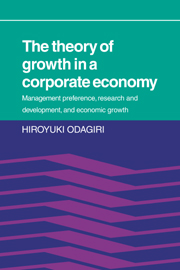 The Theory of Growth in a Corporate Economy
The Theory of Growth in a Corporate Economy Published online by Cambridge University Press: 05 November 2011
Now that we have presented our basic model of economic growth and discussed its theoretical advantage over other models, it is only appropriate that we consider here its practical applicability. Our particular subject is the rapid growth of the Japanese economy in comparison with the economic growth of other countries, specifically the United States. The purpose of this study, however, is confined to an application of our model of economic growth and is not intended to be a comprehensive study of the mechanism behind Japan's economic growth.
The facts
“Miracle” is the word that has often been used to describe the unusually high rate of economic growth in post-World War II Japan. The comparison with other advanced countries may justify this use of the word. Denison and Chung (1976, p. 42) report that the annual growth rate of total national income amounted to 8.81 percent in Japan (1953–71), more than double the figure, 4.00 percent, for the United States (1948–69). Even in West Germany (1950–62), which recorded the highest rate among the United States, Canada, and eight European countries investigated, it was 6.27 percent, less than three quarters of Japan's rate.
It is true that Japan's economic growth slowed down in the 1970s, particularly after the oil crisis of 1973. The annual rate of growth of manufacturing output, for example, declined to 4.1 percent in 1973–78 from 12.7 percent of 1960–73.
To save this book to your Kindle, first ensure [email protected] is added to your Approved Personal Document E-mail List under your Personal Document Settings on the Manage Your Content and Devices page of your Amazon account. Then enter the ‘name’ part of your Kindle email address below. Find out more about saving to your Kindle.
Note you can select to save to either the @free.kindle.com or @kindle.com variations. ‘@free.kindle.com’ emails are free but can only be saved to your device when it is connected to wi-fi. ‘@kindle.com’ emails can be delivered even when you are not connected to wi-fi, but note that service fees apply.
Find out more about the Kindle Personal Document Service.
To save content items to your account, please confirm that you agree to abide by our usage policies. If this is the first time you use this feature, you will be asked to authorise Cambridge Core to connect with your account. Find out more about saving content to Dropbox.
To save content items to your account, please confirm that you agree to abide by our usage policies. If this is the first time you use this feature, you will be asked to authorise Cambridge Core to connect with your account. Find out more about saving content to Google Drive.